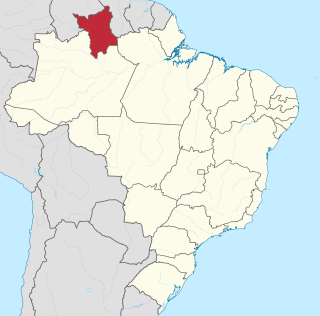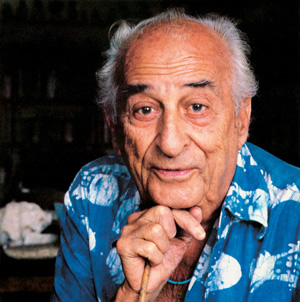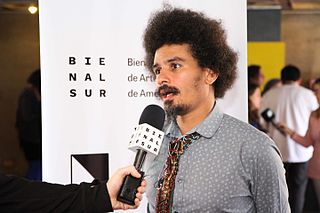Related Research Articles

Roraima is one of the 26 states of Brazil. Located in the country's North Region, it is the northernmost and most geographically and logistically isolated state in Brazil. It is bordered by the state of Pará to the southeast, Amazonas to the south and west, Venezuela to the north and northwest, and Guyana to the east.

Terra indígena Raposa/Serra do Sol is an indigenous territory in Brazil, intended to be home to the Macuxi people. It is located in the northern half of the Brazilian state of Roraima and is the largest in that country and one of the world's largest, with an area of 1,743,089 hectares and a perimeter of about 1,000 kilometres (620 mi).

The Macushi are an indigenous people living in the borderlands of southern Guyana, northern Brazil in the state of Roraima, and in an eastern part of Venezuela.

Bonfim is a municipality located in the mideast of the state of Roraima in Brazil. Its population is 12,557 and its area is 8,095 km2. The city lies opposite the Takutu River from Lethem, Guyana. The Takutu River Bridge links Bonfim and Roraima with the town of Lethem and the Atlantic port of Georgetown, Guyana.

Normandia is a city located in the northeastern region of the Brazilian state of Roraima. Normandia covers 6,960 km2 (2,690 sq mi), and has an estimated population of 11,532 as of 2020 with a population density of 1.28 inhabitants per square kilometer. The municipality consists almost entirely of indigenous areas; 98.6% of the land area of the city is part of the Raposa Serra do Sol indigenous reserve. The remaining area consists of the city seat located close to the Ireng River which forms the Brazil-Guyana border.
Brígida Baltar was a Brazilian visual artist. Her work spanned across a wide range of mediums, including video, performance, installation, drawing, and sculpture. She was interested in capturing the ephemeral in her artwork.

Héctor Julio Páride Bernabó was an Argentine-Brazilian artist, researcher, writer, historian and journalist. His nickname and artistic name, Carybé, a type of piranha, comes from his time in the scouts. He died of heart failure after the meeting of a candomblé community's lay board of directors, the Cruz Santa Opô Afonjá Society, of which he was a member.

The creation of art in the geographic area now known as Brazil begins with the earliest records of its human habitation. The original inhabitants of the land, pre-Columbian Indigenous or Natives peoples, produced various forms of art; specific cultures like the Marajoara left sophisticated painted pottery. This area was colonized by Portugal in the 16th century and given the modern name of Brazil. Brazilian art is most commonly used as an umbrella term for art created in this region post Portuguese colonization.

The history of the territory that is now Roraima, a state at the extreme north of present-day Brazil is recent, but not thereby simple. Invaded numerous times by the various countries interested in the region, the seldom-visited Roraima aroused little interest on the part of the Portuguese, especially after the arrival of the royal family in Rio de Janeiro. Meanwhile, the territory became coveted by other countries, including England, the Netherlands, and, especially, Spain.

The Pedra Pintada or "Painted Rock", is a large rock located in the state of Roraima, Brazil. It is 85 metres long, 35 metres high and 30 metres wide, and is found in the Boa Vista savanna. There are many pictograms and other archaeological evidence inscribed on the walls of the rock.
Gilvan Samico was a Brazilian painter, teacher and engraver of the Armorial Movement of graphic design.

Joênia Wapichana is the first indigenous lawyer in Brazil and a member of the Wapixana tribe of northern Brazil. After taking a land dispute to the Inter-American Commission on Human Rights, Wapixana became the first indigenous lawyer to argue before the Supreme Court of Brazil. She is the current president of the National Commission for the Defense of the Rights of Indigenous Peoples.

Willys de Castro was a Brazilian visual artist, poet, graphic designer, industrial designer, stage designer and magazine editor. De Castro is best known for his "Active object" series and is considered to be a pioneer and founding contributor of the Neo-Concrete Movement.
Renata Lucas is a Brazilian artist.
Sheila Maureen Bisilliat is an English-born Brazilian photographer.

Venezuelan Brazilians are individuals of full, partial, or predominantly Venezuelan ancestry, or a Venezuelan-born person residing in Brazil. Until the early 2010s, the immigration of this group was little expressive compared to the immigration of other South American peoples such as Argentines, Bolivians or Paraguayans. However, the crisis in Venezuela and the subsequent refugee crisis has led to Brazil becoming home to a large number of Venezuelan refugees, most of whom enter the border through the northern state of Roraima. By the beginning of the 2020, more than 200,000 of Venezuelans have migrated to the country looking for refuge.

Paulo Nazareth is a Brazilian contemporary artist based in Belo Horizonte, Brazil. Nazareth has achieved notable acclaim for his distinctive approach to contemporary art, exemplified by multimedia, performance-based works, international exhibitions, and prestigious awards such as the PIPA Prize, solidifying his status as an influential figure in the global art scene.

BR-401 is a federal highway in the state of Roraima in Brazil. The 202.9 km (126.1 mi) road connects Boa Vista with Normandia and the road network of Guyana.

Lake Caracaranã is a lake in the Normandia municipality of Roraima, Brazil. The lake is located in the Raposa Serra do Sol indigenous territory.

The Huni Kuin Artists Movement (MAHKU) is a group composed of Huni Kuin artists and researchers, an indigenous people living in the Brazilian Amazon, between the state of Acre and Peru. The group's origins are linked to Ibã Sales Huni Kuin's research on the Huni Meka, ayahuasca chants in the Hãtxa Kuin language. The artists seek to transform and create bridges with the non-indigenous through murals, drawings, and paintings, hence building alliances and strengthening their own strategies of autonomy. The group is constituted by founder Ibã Huni Kuin, Kássia Borges, Acelino Tuin, Cleiber Bane, Pedro Maná, Yaka Huni Kuin, Rita Huni Kuin, Cleudo Txana Tuin, and Isaka Huni Kuin, represented by the Carmo Johnson Projects gallery
References
- 1 2 3 Ruiz, Cristina (April 21, 2022). "Bittersweet triumph at Venice Biennale of late Indigenous artist Jaider Esbell". The Art Newspaper .
- 1 2 3 Jabra, Daniel (March 16, 2021). ""Presentation: Ruku", primer exposición individual del artista y curador indígena makuxi Jaider Esbell en Galeria Millan, Brasil".
- ↑ "Morre Jaider Esbell, artista plástico roraimense". November 2, 2021. Retrieved May 7, 2023.
- ↑ Astor, Michael (August 3, 2020). "Bernaldina José Pedro, Repository of Indigenous Culture, Dies at 75". The New York Times .
- 1 2 Moraes, Carolina (May 9, 2021). "Quem é o artista indígena que levou a cosmologia e a luta macuxi para os museus" (PDF). Folha de S. Paulo.
- 1 2 Neiva, Leonardo (December 1, 2020). "A arte é uma extensão da nossa política para este mudno". Gama Revista.
- ↑ Basciano, Oliver (March 9, 2021). "The Artists Mapping Colonial Brazil". ArtReview.
- ↑ "Jaider Esbell e arte indígena contemporânea estarão na Bienal deste ano" (PDF). Educa Roraima. February 13, 2020.
- ↑ Muniz, Leandro (July 2, 2021). "Jaider Esbell e a sobreposição de mundos". Revista SeLecT.
- 1 2 3 "Jaider Esbell". Prêmio PIPA.
- ↑ "Moquém_Surarî: arte indígena contemporânea". MAM.